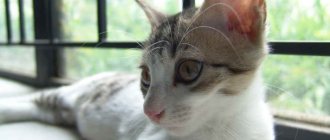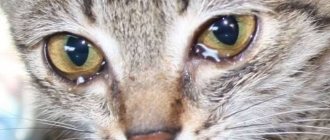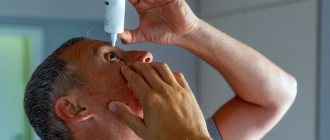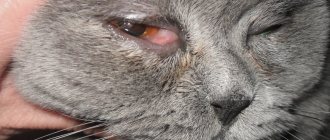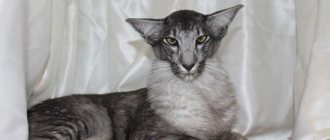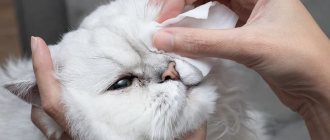Cat owners often encounter the problem of souring or severe watery eyes in their pets. In such cases, it is important to provide them with prompt assistance so that the disorder does not cause loss of vision or the appearance of a severe inflammatory process in the cornea. Small cats require special care for such problems. It is important to know how to wash your kitten's eyes. Not all medications are suitable for them, like children, due to the presence of potent chemical components in their composition.
It is important to know how to wash a kitten's eyes
Causes of discharge from a kitten's eyes
It is worth clearly knowing all the reasons when eye rinsing is required in a small animal. The first rule in this matter is that you cannot touch the mucous membrane without a real violation. Preventive treatments are never carried out on the organs of vision, as they can cause unnecessary irritation, decreased vision and can cause infections if hygiene rules are not followed.
Cat's eyes: structure, diagram
You can wash your kitten's eyes only after external changes appear that indicate the presence of pathology or foreign objects getting into the cornea. Treating the visual organs of cats is allowed if they have the following diseases and problems:
- the need to cleanse the eye to instill antibiotics in the presence of infection;
- injuries of the cornea and eyeball;
Corneal ulcer in a cat
- regular treatment of organs due to the structural features of the nasolacrimal duct;
- contact with the mucous membrane of foreign objects, including dust;
- lacrimation and mucus formation associated with exposure to an allergen; rinsing in this case reduces the concentration of the harmful substance;
- infection with worms, while the animal never experiences a high temperature;
- conjunctivitis, blepharitis and other infectious disorders that can cause accumulation of pus and mucus.
Attention! Persian cats, Scottish fold cats, and British shorthairs are distinguished by the special structure of the nasolacrimal duct. Because of this, the animal constantly produces a large amount of tears and mucus, which can clog the eyes and cause irritation. To prevent this, regular washing is carried out every 5-10 days.
Kitten with sore eyes
Features of the procedure for adult cats
Usually cats are reluctant to allow any medical manipulations to be performed on them. This makes eye rinsing difficult to do alone. It is better to do this with an assistant who will hold the animal.
- Prepare equipment: cotton pads, tissue napkins, gauze or bandage, syringes without a needle for 5 or 10 cubes.
- Wrap the animal in a towel or soft cloth to secure it.
- Moisten a cloth with warm medicinal solution and squeeze onto the affected eye.
- Wait for the crusts to soften, and then remove them with a cotton pad using movements from the outer corners of the eyes to the inner ones.
- When eyelashes stick together with pus, move the napkin from your nose to your ears to open your eyes. In this case, cotton pads need to be changed as they become dirty.
- Gently pour the solution onto the cornea of the cleaned eye using a syringe.
- Remove excess solution by dabbing the eye with a dry cloth or cotton swab wrapped in a bandage. During the procedure, try not to touch the eyeball with gauze or a swab.
Attention! Before washing your cat's eyes, you should not wipe them with dry cotton wool, as this will lead to even greater irritation of the eye organs.
Symptoms and possible eye diseases in kittens
The need to use eye wash solutions in a pet is determined by the nature of the signs of the disorder and the nature of the discharge from the mucous membrane.
- The appearance of thick mucus, in which pus is noticeable, is most often associated with fungal infection and infections. The mucus has an unpleasant odor, yellow color and often leads to complete sticking of the eyelids. Cats often develop a fever, weakness, and loss of appetite.
- When the mucous membrane or cornea is injured and the allergic reaction spreads, the animal suffers due to the release of watery and clear fluid. At the same time, you can observe redness of the eyes, itching, and constant blinking.
- If tears are constantly released from the eyes, which after drying take on a dark or crusty appearance, we can talk about dirt and dust getting into the mucous membrane. With this disorder, eye hyperemia may also occur.
Conjunctivitis in a cat
When is the procedure required?
Such manipulations may be required if there is any inflammation. It can be triggered by injury, entry of a foreign object (small insect, pollen or speck), the development of conjunctivitis, viral infections, allergic manifestations, entropion of the eyelid or infection with worms.
You can determine what exactly caused the inflammatory process in a cat by the nature of the discharge. Thick and yellowish discharge, the presence of pus and sticking of the eyelids indicate the appearance of an infectious, bacterial or fungal disease. If the discharge is clear and watery, the animal rubs its eyes with its paws, there is an injury or allergy. Transparent drops dried in the corners are a sign of dirt or dust.
Traditional preparations for washing the eyes
If for some reason the kitten’s owner does not want to use medical solutions for rinsing or they simply are not at hand, but immediate assistance is required, unconventional drugs can be used. It is important to follow the dosages of the components used and not exceed the recommended number of medications.
Table 1. Traditional methods for washing the eyes of kittens.
| Ingredient | Cooking method | Dosage | A course of treatment |
| pharmaceutical camomile |
|
| Until symptoms are completely cured |
| Manganese crystals |
|
| No more than 3-5 days |
| Calendula |
|
| Until symptoms are completely suppressed |
| Series |
|
| Until symptoms are completely eliminated |
Attention! Manganese solution should be used with great caution in treatment. It is necessary to achieve complete dissolution of the crystals so that they do not burn the cornea and adjacent skin.
Ready-made calendula solution for washing
Folk remedies
Like a person, a pet can respond positively not only to drug treatment, the components of which are purchased at the pharmacy. It never hurts to try folk remedies, and if they don’t work, expand your arsenal of drugs. Among the folk remedies they recommend:
- Chamomile decoction . This useful plant is used not only internally to calm the nerves of animals. By mixing two teaspoons of dried chamomile and 60 ml of hot water, you can prepare a product suitable for rinsing. Before use, you need to leave it for 5 minutes and then strain well.
- The tea left over from home gatherings can also be used for the benefit of the animal. The brew disinfects and soothes the inflamed mucous membrane and skin around the eyes. The tea does not have to be fresh; you can use yesterday's tea. Very old tea leaves will not work - bacteria will already have time to multiply in it.
- A weak solution of potassium permanganate is also suitable for treating the eyes . It should be pale pink. If small crystals float in the liquid, the solution must be filtered.
If your pet’s eye problems have not been resolved, you should definitely visit a veterinary clinic so that the doctor can select the optimal treatment regimen.
Medicinal eye washes
Diamond Eyes Drops
An effective medication for suppressing many visual disorders. The drops contain taurine and succinic acid. This combination produces a powerful antibacterial and decongestant result, relieves severe and mild inflammatory processes. Used to eliminate infectious lesions, dissolve crusts in the corner of the eyes, treat acute and chronic conjunctivitis, and are suitable for the complex treatment of allergic reactions.
When using Diamond Drops, the following dosages are observed:
- to wash the exudate and treat mild chronic conjunctivitis, it is enough to use 1 drop of solution every 5-10 days; the product can be used up to three times a day;
- if the kitten’s condition requires taking medication daily, you cannot use it for more than 45 days, after each course there is a break of 10 days;
- with double treatment, eye drops cannot be instilled every day for more than 20 days, the break after each course is one week;
- with three treatments every day, eye drops cannot be used for more than two weeks; after each course, a break of at least five days is required;
- If your pet is diagnosed with increased tear secretion, redness, foreign body penetration and injury, it is recommended to prescribe drops three times a day for no more than two weeks.
The drops are well tolerated by kittens and, if the dosage is observed, do not provoke any negative reactions.
Veterinary drug Diamond eyes for prevention and treatment
Saline solution at a concentration of 0.9% of the active substance
It must be purchased only in pharmacies; it is very difficult to independently bring the concentrate to the required dose of 0.9%. If this amount of active substance is exceeded, there is a high risk of redness and burns of the eyeball. The solution is used up to three times a day for external treatment of the eye. If necessary, it can be used dropwise in one dose no more than twice a day. Duration of use – up to two weeks.
Ophthal
Drops are used to eliminate irritation due to sand, dust, and the release of tears during an allergic reaction. Use the medication for no more than three days at a concentration of 0.5 mg/ml of the active substance. For rinsing and treatment, it is enough to instill one drop of Ophthal no more than twice a day.
Ophthal drops for treating and washing the eyes of kittens
Dewdrop
Hygienic lotion based on chamomile and sage. Used to remove dust, dirt, accumulated exudate, and additionally cares for the skin. Well tolerated by kittens. To eliminate the problem, you need to moisten a sterile swab with lotion and soften the accumulated crusts with it. Once they are removed, you should wipe the eye again. Treatment is carried out once a day, if necessary, a repeated procedure is allowed. Between uses of Rosinka lotion, a 5-10 day break is required for regular care.
Dewdrop
Anandin
Drops prescribed in the presence of increased lacrimation due to allergic rhinitis or conjunctivitis. Taking into account the severity of the kitten’s condition, 1-2 drops of the drug are instilled into the lower eyelid no more than twice a day. Sometimes a single dose can be increased to 2-3 drops, but usually this dosage is used only for adults. The recommended course of therapy is no more than two weeks.
Read more about the use of the drug "Anandin" for cats, the characteristics of the drug, and side effects here.
How to properly care
The most common method is washing. They use various lotions, decoctions and infusions of medicinal herbs. If you have to take care of a cat’s sore eyes, your veterinarian will prescribe certain medications. Instillation of drops and application of medicinal gels and ointments are also often used.
Rinsing is carried out as follows: a small amount of the lotion used is applied to a clean swab (gauze, cotton-gauze, you can also use a napkin), but so as to moisten the fabric abundantly. Confidently holding a wet swab in your right hand (for left-handed people - in your left hand), hold the cat's head from the side with your other hand. With a precise, gentle movement, wipe the eyelids, removing dirt. You should move in one direction along the growth of the fur, that is, from the inner edge to the outer corner of the eye. The inner corner is wiped towards the nose. The same is done with the second eye.
If there are problems with the eyes, and the doctor has prescribed abundant washing, irrigation of the mucous membranes of the eye, you need to draw the required amount of the prescribed medicine into a syringe without a needle, pull back the eyelid, and, pointing the nozzle of the syringe at the mucous membranes, irrigate the affected areas under light pressure. To do this, the piston should be pressed in slowly and evenly. If you cannot control the pressure, it would be more rational to use a pipette, from which you carefully drop the medicine into the eye. Then gently wipe the leaked excess from the muzzle with a swab.
For your information! Be sure to wash your hands before rinsing or putting drops in your cat's eyes. It is also worth remembering that a separate disposable swab is used for each eye and, if necessary, changed several times during the procedure.
If your cat has been prescribed eye drops, all crusts and other contaminants must be removed before instillation. The eyelids are thoroughly wiped and the eyes are washed if necessary. If the stains are abundant and dried, they need to be soaked and then removed. Drops are instilled into the inner corner, onto the mucous membrane of the eye. To do this, hold the cat securely, pull back the lower eyelid in the same way as during examination, directing the spout of the bottle or pipette (depending on how the medicine is stored) to the desired place, lightly press on the body of the bottle, and a drop will be released. Having counted out the required amount, do the same with the second eye.
Ointments and gels are placed in the prepared eye, also behind the lower eyelid. You can squeeze it onto your finger or onto a glass rod, then apply it to your eye. This makes it more convenient and easier to dose the amount of medicine, as well as control the pressure and direction of putting the medicine. There is no need to squeeze the ointment into the eye directly from the tube. You can easily injure this delicate organ of vision, as well as disrupt the purity of the remaining medicine in the package.
After applying the ointment or gel, you need to massage the closed eye a little in a circular motion. This helps distribute the medication evenly and remove excess.
Eye lotion
Solutions for rinsing for inflammations of an infectious nature
Such medications should be used for bacterial conjunctivitis, blepharitis, and purulent eye lesions. It is recommended to select dosages of antibacterial drugs under the supervision of the attending physician, since it is important to take into account the kitten’s age, its weight and an accurate diagnosis.
Furacilin solution
To treat kittens, you need to purchase a ready-made medication solution from a veterinary pharmacy. Furacilin eliminates redness, irritation, swelling and discharge of purulent masses. It is worth carefully observing the dosages of active substances, since if used incorrectly, the drug increases the negative symptoms of the disease. It is difficult to prepare the solution yourself, since no more than one gram of antibacterial substance is required per 5 liters of water to treat kittens. When treating, the veterinarian usually prescribes 1 drop of solution in each eye twice a day. The drug can be used externally three times a day. The course of treatment depends on the degree of the disorder and can last 3-7 days.
You can prepare a solution of furatsilin yourself
Boric acid solution
You can prepare it yourself at home. To do this, dissolve 5 g of the active substance in 200 ml of boiled water and stir well. Used only for external treatment 2-3 times a day for 3-7 days. Boric acid should not be prescribed in the presence of open wounds, skin lesions and bleeding.
Tsiprovet
Antibacterial drops used to suppress the activity of gram-positive and gram-negative bacteria. Accelerate the recovery of affected tissues. To treat kittens, one drop of the solution should be instilled. If hygienic treatment of the eyes and elimination of purulent mucous accumulations are necessary, first instill 3-4 drops of the active substance. The sore eyelid is wiped with a sterile swab and a drop of Tsiprovet is instilled again. The duration of use of drops is according to indications.
Tsiprovet
How to carry out the procedure
At home, you can wash your cat's eyes with pharmaceutical solutions or products made from available ingredients.
The most current pharmacy option is to rinse your eyes with Furacilin. This is a cheap remedy that allows for home treatment. But it is important to purchase a 0.02% solution and be very careful when using it, since an increased concentration will cause new irritation to your pet’s eyes.
Other medications that can be used to rub your kitten's eyes include:
- Boric acid - it must be used if the case of inflammation is not accompanied by a violation of the integrity of the mucous membranes and bleeding.
- A saline solution, which is sold in a pharmacy with a concentration of 0.9%, which allows you to avoid errors in proportions and cause a burn to the mucous membrane of the eye.
- Chlorhexidine 0.01%, which is easy to use at home.
- Potassium permanganate - it should be barely noticeable, pink in color, and it is important that there are no undissolved crystals, otherwise a chemical burn will occur.
- Drops for cats, such as “Diamond Eyes”, are a drug developed by veterinarians; they do not damage the cat’s eye, thanks to the safe proportions of the constituent elements.
- Drops with antibiotics, for example, Ciprofloxacin or Levomycetin, they are used mainly for purulent conjunctivitis.
To remove pathological discharge from a cat’s eye without resorting to buying special medications at the pharmacy, you can make home remedies:
- Simple black tea. In order to wash a kitten’s eyes, you need to brew tea, not very strong, and, after straining it from the tea leaves, leave it for 10-12 hours before the procedure.
- Herbal decoction. It requires chamomile, St. John's wort or calendula. Take any of these herbs in dry form, in an amount of about 1-2 teaspoons, pour half a glass of boiling water over it, and let it stand for 10 minutes.
But the simplest and most convenient home way to treat your pet’s eyes is plain water. The only important thing is that it should be boiled and lukewarm so as not to burn his mucous membranes.
Tea and chlorhexidine: can you wash a kitten’s eyes with them?
The use of tea leaves is possible only if the owner is sure that the kitten’s eyes are not turning sour due to the presence of a disease. Tea is used for regular treatments when a foreign body enters without injuring the eye. In this case, you need to use only yesterday’s brew without sugar, flavorings and other additives. Using tea, you can wash the surface of the eye and eyelids up to five times a day until the disturbances disappear.
Chlorhexidine is one of the safest antiseptics that is used as regular and medicinal care. The substance is prescribed for allergies, infections, injuries and other problems. But since the drug is available in high concentrations, it should be brought to the correct level for the pet. If this is not done, your pet will develop local reactions in the form of redness, irritation, increased lacrimation, and there is also a high risk of burns.
Chlorhexidine
For kittens and cats, a 0.01% solution is used. To obtain it, you need to combine 4 ml of a 0.05% Chlorhexidine solution and 16 ml of sterile saline solution at a concentration of 0.9% in a 20 cc syringe. You can treat the diseased surface up to 3 times a day, instill no more than one drop also three times a day.
Attention! It is worth considering that the active substance Chlorhexidine can cause increased dryness and interfere with the hydration of the eye. To prevent this from happening, it is enough to follow the instructions and avoid overdose.
Instillation and rinsing of a kitten's eye from a bottle
How to wash a cat's eyes
In most cases, you do not have to specifically buy medicines - just open your home medicine cabinet. It will probably contain some of the tools listed below.
How to rinse a cat's eyes using medications
In any pharmacy you can buy products for people suitable for washing the eyes of animals.
You may already have them
- ready-made solution of furatsilin 0.02%;
- saline solution 9 percent;
- 2% boric acid solution;
- chlorhexidine 0.01%.
Always pay attention to the percentage! If you make a mistake, you can cause a severe chemical burn.
Other medicines from the human pharmacy cannot be used for cats - you may be confused with the dosage or intolerance. If treatment for a serious illness is required, the veterinarian will issue a prescription.
You can purchase eye wash products for cats and kittens at a veterinary pharmacy:
- “Diamond eyes” with chlorhexidine, taurine and chlorocide C, that is, the effect of the drug is complex: bactericidal and healing;
- “Bars” are medicinal drops containing furatsilin (disinfects) and novocaine (pain relievers), often used in the form of lotions.
If your cat becomes allergic to any of the medications, stop using it immediately.
Folk remedies
To prevent diseases and for minor discharge, you can use weak herbal decoctions from your home medicine cabinet. It is best to wash a kitten's eyes with herbs after consultation with a veterinarian, so as not to provoke an allergic reaction. What folk remedies can you use to wash a cat's eyes?
- a small amount of strong black tea;
- you can brew calendula: 1 tbsp. a spoonful of flowers - one mug of boiling water;
- according to the same principle - a decoction of St. John's wort;
- For a one-time procedure, chamomile is also suitable - 1 sachet/tbsp. spoon onto a mug of boiling water.
Monitor the temperature of the medicine - it should be at room temperature. Before rinsing your pet’s eyes, it is necessary to strain the broth so that foreign particles do not get into your pet’s eye and cause complications.
General rules and recommendations for eye treatment and eye drops
Veterinarians' advice on this matter is always the same. Since the kitten will definitely not like such manipulations, it is necessary to carry out the procedure quickly, without distraction. Additionally, the following rules are observed.
- Before starting the procedure, the owner should wash their hands well with soap to avoid introducing additional infection and dirt into the kitten’s eyes.
Before procedures, wash your hands with soap
- It is better to carry out processing in pairs. One owner should place the pet on its back, placing it most comfortably on its lap. At the same time, it is important to secure the cat’s paws well so that he does not cause additional injuries to himself.
- The pet should lie down so that its head is higher than the rest of the body.
- The maximum temperature of the solution for washing and instillation should not exceed +37 degrees, otherwise the mucous membrane will be severely burned, which can lead to complete loss of vision.
- The bottle with the drug and the pipette are kept at a distance of at least 1 cm from the eyeball. If necessary, you can instill the medication using a sterile syringe without a needle.
- If the kitten's eyelids are very stuck together, you need to first squeeze a small amount of medicine onto them. After waiting a little, the mucus is removed using a clean swab. As soon as the eyes are opened, eye drops are instilled.
- When opening stuck eyelids, movements after using the medicine must be carried out from the bridge of the nose to the temples. Do not press hard or rub the sore spot, this will only increase irritation and cause pain to your pet.
- After opening the eyes, it is recommended to wipe them again with a dry swab to dry the fur a little.
We wipe the kitten's eyes with a cotton swab
- Under no circumstances touch the mucous membrane of your pet's eye with dry objects, they remove the top layer of corneal cells, provoke inflammation and cause severe pain. In addition, lint from a dry swab can remain on the eye, increasing unpleasant symptoms.
- Also, you should not touch the surface of the eye with your hands; any debris is removed with a wet swab with light blotting movements.
Video - Treating a cat's eye
Attention! To achieve maximum effect, veterinarians advise bringing the lower and upper eyelids together after using eye drops. This is required for complete distribution of the drug throughout the mucosa.
Precautionary measures
It is permissible to clean the affected areas only with a solution at room temperature to avoid burning the eyeball. A bottle with drops, a pipette or a syringe without a needle must be located above the ocular surface. Do not touch the cornea, only the eyelids or the area around the eye sockets. It is also forbidden to blot the eyeball itself due to the risk of damaging it.
Most often, if all recommendations are followed, it is possible to treat your pet at home, even without visiting a veterinarian.
Causes of tearing and souring
If your cat’s eyes are red and inflamed, there is constant tearing, accumulation of mucus, or, worse, inflammation, then this is a serious reason to immediately visit a veterinarian, who will examine the animal and determine the cause of such symptoms. The types of eye diseases in cats, like in humans, are very diverse.
Moreover, the eyes are a mirror not only of the animal’s soul, but also of the entire organism as a whole, so problems with the eyes can signal much more serious problems. Therefore, before rinsing your cat’s eyes, it would be good to determine the cause of the disease.
Inflammation can be caused by various diseases:
- conjunctivitis - inflammation of the mucous membrane, usually produces, in addition to lacrimation, purulent discharge;
- protrusion of the third eyelid - signals injury or the presence of viruses or worms in the animal’s body;
- keratitis - an inflammatory process in the cornea;
- cataract – clouding of the lens;
- glaucoma – increased intraocular pressure with clouding of the cornea;
- bulging eye - usually indicates injury or tumor;
- lacrimation - may be caused by the tear duct being blocked or producing too much tears.
When and why is rinsing necessary?
Animals are not always able to remove accumulated discharge from the outer and inner corners of the eyes. Therefore, the owner needs to periodically help the pet with hygiene. In other cases, rinsing becomes one of the methods of therapy when it is necessary to cure an eye disease.
Causes and symptoms of eye diseases
There is no need to panic if your pet’s eyes begin to water - perhaps a speck of dust has landed on the cornea, and the body has activated a protective reaction in the form of profuse lacrimation. Such conditions quickly, within one day, cease without human help. But there are also more serious cases - eye damage or diseases:
- Scratches and wounds. A pet can get eye injuries during a fight, play, or fall. Symptoms include redness, swelling, and in rare cases, bleeding.
- Entry of a foreign body. Accompanied by severe lacrimation, redness of the eyelid and cornea; if the speck remains in the eye for a long time, pus may appear.
- Inflammation of the eyelids, or blepharitis. With ordinary inflammation, the cat begins to scratch its eyes, as a result of which the eyelids turn red. With phlegmous inflammation, the eyelid swells and cloudy mucus oozes from the eye. Blepharitis often occurs after severe scratching and wounds, that is, it is a secondary infection.
- Inversion and inversion of the eyelid. Abnormal position of the eyelid occurs when a foreign body enters, when exposed to strong chemicals, or from burns. This can lead to conjunctivitis or keratitis (inflammation of the cornea). Symptoms: lacrimation, photophobia, redness of the conjunctiva.
- Parasitosis. Some types of helminths settle in unexpected parts of the body, including the eye area.
- Infections are one of the most dangerous conditions. The outbreak can be concentrated only in the eye (viral conjunctivitis) or affect the entire body (distemper, chlamydia, etc.). The infection is characterized by swelling and narrowing of the eyes, copious discharge with pus, crusting and sticking of the eyelids.
- Allergies – just like in humans, a cat’s eyes may become watery due to an allergy to pollen, citrus particles, perfume, etc. In this case, redness of the eyelids and strong transparent discharge are observed.
There are breeds of cats in which eye problems occur more often due to anatomical features: these are British, Rex, Sphynx. They require more careful care.
To avoid or prevent illness, it is necessary to periodically check your cat's eyes - every day, as soon as you pick up your pet, briefly examine its face. Do not forget to carefully remove accumulated dirt and vaccinate once a year.
Indications for eye rinsing
Sometimes an animal is not able to wash itself thoroughly: due to young or old age, illness, too long hair on the face and other reasons. Then it is recommended to pay attention to this once every 1-2 days - for hygiene purposes.
More frequent rinsing is needed if the pet becomes ill. Simple strong tea will not help here - you need medicines, drops and ointments. Only a veterinarian will tell you the procedure for their use after examination and making an accurate diagnosis.
Precautions
In case of severe illnesses, you should not self-medicate without the advice of a veterinarian. This can lead to serious complications, including loss of the eye. Therapy must be agreed upon with a specialist, who will also calculate the dosage and course of drug use.
If everything is not so serious and the cat needs a banal cleansing, you can carry out the procedure yourself several times until the condition improves. Remember the contraindications and precautions:
- do not rinse your eyes with plain water - it destroys the natural microflora and dries out;
- do not use cotton wool - its fibers can damage the cornea or get under the eyelid, so take cotton pads or a gauze swab;
- each eye should have its own disc or tampon to avoid spreading infection from one eye to the other;
- Do not wash your cat's eyes with chamomile infusion, as this often leads to baldness of the eyelids.
Always follow through with treatment. If after two days of washing the furry patient’s condition has not improved, contact your veterinarian.
